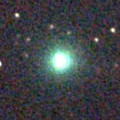
|
It brightened very rapidly. Now it is very bright as 9.0 mag (Sept. 7, Chris Wyatt). It stays bright as 8-9 mag until October. The condition is bad in this apparition. In the Southern Hemisphere, it stays observable after this while the comet will be fading. But it stays locating low. It is not observable after this in the Northern Hemisphere.
Date(TT) R.A. (2000) Decl. Delta r Elong. m1 Best Time(A, h)
Sept.11 9 28.17 -5 56.7 1.808 1.049 29 8.6 4:13 (276, -2)
Sept.18 9 51.42 -11 38.0 1.812 1.076 30 8.5 4:20 (282, -3)
|
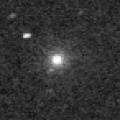
|
It was observed at 9-10 mag from late July to early August. Now it is not observable. It will appear in the morning sky in December, but it will be fainter than 15 mag at that time.
Date(TT) R.A. (2000) Decl. Delta r Elong. m1 Best Time(A, h)
Sept.11 11 34.69 14 44.9 1.921 0.952 11 10.2 19:38 (114, -8)
Sept.18 12 2.41 10 46.5 2.003 1.029 10 10.6 19:27 (109, -9)
|
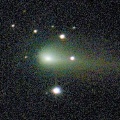
|
Now it is 10.4 mag (Sept. 4, Marco Goiato). It stays observable at 10-11 mag in excellent condition from summer to autumn.
Date(TT) R.A. (2000) Decl. Delta r Elong. m1 Best Time(A, h)
Sept.11 5 16.03 18 17.5 1.292 1.619 88 10.4 4:13 (300, 62)
Sept.18 5 33.17 17 42.5 1.248 1.622 91 10.4 4:20 (306, 64)
|
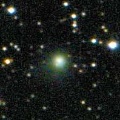
|
Now it is 10.9 mag (Sept. 2, Martin Masek). It will brighten up to 10 mag in winter. In the Northern Hemisphere, it stays observable in good condition for a long time. In the Southern Hemisphere, it is not observable until November.
Date(TT) R.A. (2000) Decl. Delta r Elong. m1 Best Time(A, h)
Sept.11 7 9.38 44 44.4 3.997 3.720 66 11.1 4:13 (240, 48)
Sept.18 7 17.35 44 10.9 3.893 3.702 71 11.0 4:20 (241, 53)
|
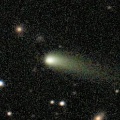
|
Now it is 12.1 mag (Sept. 1, Martin Masek). It will brighten up to 9 mag, and will be observable in good condition in winter.
Date(TT) R.A. (2000) Decl. Delta r Elong. m1 Best Time(A, h)
Sept.11 3 37.57 15 57.9 0.625 1.372 112 11.5 4:13 (357, 71)
Sept.18 4 4.21 17 57.1 0.574 1.334 112 11.1 4:16 ( 0, 73)
|
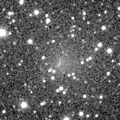
|
Now it is bright as 12.5 mag (Aug. 31, Chris Wyatt). It will brighten very rapidly, and it will be observable at 10 mag in good condition from October to December. In the Northern Hemisphere, it locates somewhat low at the high light.
Date(TT) R.A. (2000) Decl. Delta r Elong. m1 Best Time(A, h)
Sept.11 17 36.64 -19 13.7 0.807 1.357 96 11.6 19:38 ( 23, 32)
Sept.18 17 58.26 -22 29.0 0.832 1.355 94 11.2 19:27 ( 20, 30)
|
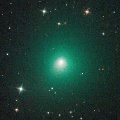
|
Now it is very bright as 10.9 mag (Sept. 8, Chris Wyatt). It will be fading after this. In the Northern Hemisphere, it will be getting lower gradually in the evening. In the Southern Hemisphere, it stays observable in good condition for a while.
Date(TT) R.A. (2000) Decl. Delta r Elong. m1 Best Time(A, h)
Sept.11 15 36.68 -18 40.1 2.347 2.182 68 11.3 19:38 ( 50, 18)
Sept.18 15 50.44 -20 41.0 2.442 2.212 64 11.5 19:27 ( 49, 16)
|
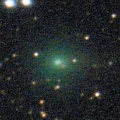
|
It brightened very rapidly up to 10.7 mag in July (July 20, Osamu Miyazaki). Now it is fading. It has already faded down to 13.5 mag (Sept. 4, Sandor Szabo). It stays observable in the morning sky for a long time.
Date(TT) R.A. (2000) Decl. Delta r Elong. m1 Best Time(A, h)
Sept.11 7 21.14 26 56.4 1.461 1.299 60 11.7 4:13 (263, 41)
Sept.18 7 39.32 26 48.0 1.479 1.360 63 12.2 4:20 (265, 44)
|
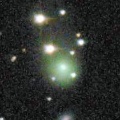
|
Now it is 12.2 mag (Aug. 29, Toshihiko Ikemura, Hirohisa Sato). It is expected to be observable at 5-6 mag for a long time from 2022 to 2023. In the Northern Hemisphere, it is not observable at the high light from 2022 autumn to 2023 summer. In the Southern Hemisphere, it stays low for a while. But it will be observable in good condition at the high light.
Date(TT) R.A. (2000) Decl. Delta r Elong. m1 Best Time(A, h)
Sept.11 16 56.70 30 32.8 5.398 5.376 83 12.0 19:38 ( 89, 64)
Sept.18 16 57.15 29 5.2 5.409 5.316 79 11.9 19:27 ( 88, 60)
|
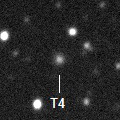
|
Now it is 14.6 mag (July 12, Chris Wyatt). It is expected to brighten up to 11.5 mag in 2022. In the Southern Hemisphere, it stas observable in good condition for a long time, although it becomes extremely low temporarily from August to September. In the Northern Hemisphere, it is not observable until November.
Date(TT) R.A. (2000) Decl. Delta r Elong. m1 Best Time(A, h)
Sept.11 10 20.22 -23 4.5 5.631 4.795 30 13.5 4:13 (283,-22)
Sept.18 10 28.08 -23 23.3 5.602 4.769 31 13.5 4:20 (287,-17)
|
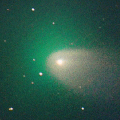
|
It brightened up to 9.7 mag in June (June 4, Michael Jager). Now it is fading. It has already faded down to 13.6 mag (Sept. 8, Chris Wyatt). In the Southern Hemisphere, it stays observable in excellent condition for a long time. In the Northern Hemisphere, it becomes extremely low after this.
Date(TT) R.A. (2000) Decl. Delta r Elong. m1 Best Time(A, h)
Sept.11 23 34.09 -51 18.6 0.904 1.754 133 13.5 0:16 ( 0, 4)
Sept.18 23 27.03 -50 16.5 0.976 1.807 131 13.9 23:36 ( 0, 5)
|
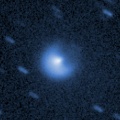
|
Now it is visible visually at 14.4 mag (Sept. 7, Chris Wyatt).
Date(TT) R.A. (2000) Decl. Delta r Elong. m1 Best Time(A, h)
Sept.11 4 54.85 31 25.5 5.787 5.912 92 13.6 4:13 (276, 72)
Sept.18 4 56.43 31 36.1 5.680 5.914 98 13.6 4:20 (284, 79)
|
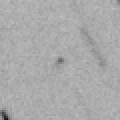
|
Now it is 15.0 mag (Sept. 8, Chris Wyatt). It will brighten rapidly up to 9 mag in winter. It will be observable in good condition. In the Southern Hemisphere, it is observable in excellent condition. In the Northren Hemisphere, it is not observable until November.
Date(TT) R.A. (2000) Decl. Delta r Elong. m1 Best Time(A, h)
Sept.11 23 58.87 -57 43.7 1.297 2.060 126 13.9 0:40 ( 0, -3)
Sept.18 23 48.89 -58 34.1 1.270 2.007 123 13.6 0:03 ( 0, -3)
|

|
Now it is 13.8 mag (Sept. 8, Chris Wyatt). It will be unobservable soon. However, it will be observable again at 14 mag in November in the Northern Hemisphere, or in January in the Southern Hemisphere.
Date(TT) R.A. (2000) Decl. Delta r Elong. m1 Best Time(A, h)
Sept.11 13 46.79 -3 57.0 4.352 3.619 38 13.6 19:38 ( 80, 7)
Sept.18 13 49.26 -3 35.2 4.453 3.644 32 13.7 19:27 ( 82, 5)
|
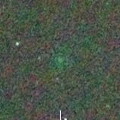
|
It brightened up to 4 mag in major outburst in 2016. In this apparition, it brightened up to 10.5 mag in early August (Aug. 8, Rob Kaufman). Now it is fading rapidly. It has already faded down to 14.0 mag (Aug. 31, Chris Wyatt). In the Southern Hemisphere, it stays locating low in the evening sky until October. In the Northern Hemisphere, it stays locating extremely low.
Date(TT) R.A. (2000) Decl. Delta r Elong. m1 Best Time(A, h)
Sept.11 13 54.59 -5 59.9 1.890 1.307 40 13.7 19:38 ( 77, 8)
Sept.18 14 20.07 -7 48.9 1.959 1.365 40 14.3 19:27 ( 74, 8)
|
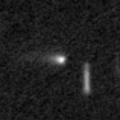
|
Now it is 14.2 mag (Sept. 3, Michael Jager). It will approach to Earth down to 0.2 a.u. in December, and it is expected to brighten up to 4 mag. In the Northern Hemisphere, it stays observable in good condition for a long time until December while the comet is brightening gradually, although it becomes extremely low temporarily in September. In the Southern Hemisphere, it is not observable until mid December.
Date(TT) R.A. (2000) Decl. Delta r Elong. m1 Best Time(A, h)
Sept.11 11 1.81 40 5.5 2.881 2.144 35 14.1 4:13 (226, 8)
Sept.18 11 7.41 39 13.1 2.740 2.045 38 13.8 4:20 (230, 11)
|

|
Now it is 14.5 mag (Aug. 10, Chris Wyatt). It stays 13-14 mag from 2020 to 2021. It will be observable in good condition after this in the Southern Hemisphere. It locates low in the Northern Hemisphere.
Date(TT) R.A. (2000) Decl. Delta r Elong. m1 Best Time(A, h)
Sept.11 18 48.04 -35 25.6 2.544 3.057 111 14.5 19:38 ( 3, 20)
Sept.18 18 51.92 -35 16.3 2.645 3.069 105 14.6 19:27 ( 5, 20)
|
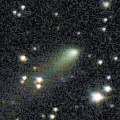
|
Now it is 13.4 mag (Sept. 3, Sandor Szabo). It stays 14 mag until October, and it is observable in good condition. It locates somewhat low in the Southern Hemisphere.
Date(TT) R.A. (2000) Decl. Delta r Elong. m1 Best Time(A, h)
Sept.11 16 27.22 24 21.1 2.312 2.302 76 14.6 19:38 ( 83, 55)
Sept.18 16 19.91 22 56.7 2.430 2.297 70 14.7 19:27 ( 85, 50)
|
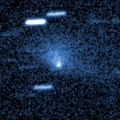
|
It brightened up to 10.1 mag in spring (Apr. 10, Marco Goiato). Now it is fading. It has already faded down to 14.7 mag (Sept. 3, Michael Jager). It stays observable in good condition for a long time after this while the comet will fading.
Date(TT) R.A. (2000) Decl. Delta r Elong. m1 Best Time(A, h)
Sept.11 4 48.11 8 24.1 1.818 2.173 96 14.6 4:13 (323, 58)
Sept.18 4 52.14 8 4.7 1.779 2.217 101 14.7 4:20 (336, 61)
|

|
Now it is 14.7 mag (Sept. 8, Chris Wyatt). It stays 14-15 mag until the end of 2021. In the Southern Hemisphere, it stays observable in good condition for a long time. It locates low in the Northern Hemisphere.
Date(TT) R.A. (2000) Decl. Delta r Elong. m1 Best Time(A, h)
Sept.11 22 53.40 -31 58.9 3.635 4.549 152 14.7 23:30 ( 0, 23)
Sept.18 22 47.21 -31 17.1 3.684 4.568 147 14.7 22:57 ( 0, 24)
|
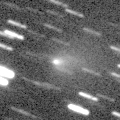
|
Outburst occured in early August. Now it is 15.2 mag (Aug. 25, Thomas Lehmann). In the Northern Hemisphere, it stays observable in good condition. In the Southern Hemipsphere, it stays locating extremely low after this.
Date(TT) R.A. (2000) Decl. Delta r Elong. m1 Best Time(A, h)
Sept.11 5 30.14 43 7.6 2.466 2.570 84 14.8 4:13 (241, 66)
Sept.18 5 38.69 43 51.8 2.410 2.598 89 14.9 4:20 (237, 70)
|
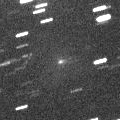
|
Bright new periodic comet. Now it is 14.7 mag (Sept. 3, Michael Jager). It stays observable in good condition for a long time. It stays 15 mag until November. Juan Jose Gonzalez reported it is very bright as 11.5 mag on Sept. 5.
Date(TT) R.A. (2000) Decl. Delta r Elong. m1 Best Time(A, h)
Sept.11 7 37.42 19 46.4 1.496 1.241 55 14.8 4:13 (269, 35)
Sept.18 8 1.85 17 42.8 1.495 1.253 56 14.9 4:20 (272, 35)
|

|
Now it is 14.9 mag (Sept. 8, Chris Wyatt). It was expected to brighten up to 13 mag from spring to summer. But actually, it is fainter than originally expected. It stays 14-15 mag until early autumn. In the Southern Hemisphere, it stays observable in good condition for a long time. In the Northern Hemisphere, it is not observable until July in 2022.
Date(TT) R.A. (2000) Decl. Delta r Elong. m1 Best Time(A, h)
Sept.11 20 40.42 -84 8.2 3.370 3.668 99 15.0 21:22 ( 0,-29)
Sept.18 20 43.63 -82 48.5 3.420 3.681 97 15.0 20:57 ( 0,-28)
|

|
Now it is 15.2 mag (Sept. 8, Chris Wyatt). It stays at 14-15 mag for a long time from 2021 to 2022. It stays observable in good condition after this while brightening gradually.
Date(TT) R.A. (2000) Decl. Delta r Elong. m1 Best Time(A, h)
Sept.11 16 20.70 -15 40.9 5.123 5.010 77 15.0 19:38 ( 44, 27)
Sept.18 16 20.55 -16 36.4 5.238 5.006 71 15.1 19:27 ( 47, 24)
|
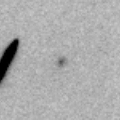
|
Now it is 15.2 mag (Aug. 27, Toshihiko Ikemura, Hirohisa Sato). It stays 15 mag until November. It will be observable in excellent condition in the Northern Hemisphere. It locates somewhat low in the Southern Hemisphere.
Date(TT) R.A. (2000) Decl. Delta r Elong. m1 Best Time(A, h)
Sept.11 5 27.79 22 2.4 1.399 1.660 85 15.2 4:13 (290, 62)
Sept.18 5 44.56 23 8.2 1.349 1.662 88 15.2 4:20 (293, 66)
|
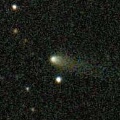
|
Now it is 14.9 mag (Aug. 30, Toshihiko Ikemura, Hirohisa Sato). It stays 15 mag until October, and it is observable in good condition.
Date(TT) R.A. (2000) Decl. Delta r Elong. m1 Best Time(A, h)
Sept.11 23 12.50 -13 34.1 1.296 2.296 171 15.3 23:49 ( 0, 41)
Sept.18 23 9.15 -14 40.0 1.311 2.296 164 15.3 23:19 ( 0, 40)
|
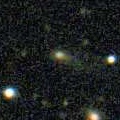
|
Now it is 15.7 mag (Sept. 3, Sandor Szabo). It will brighten very rapidly up to 14-15 mag, and it will be observable in excellent condition in autumn.
Date(TT) R.A. (2000) Decl. Delta r Elong. m1 Best Time(A, h)
Sept.11 0 25.16 2 9.9 0.819 1.802 161 15.6 1:06 ( 0, 57)
Sept.18 0 25.01 1 19.3 0.784 1.780 168 15.4 0:38 ( 0, 56)
|
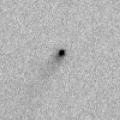
|
Now it is 15.9 mag (Aug. 27, Toshihiko Ikemura, Hirohisa Sato). It stays 15 mag until September. In the Northern Hemisphere, it stays observable in good condition for a long time. In the Southern Hemisphere, it will be getting lower gradually after this.
Date(TT) R.A. (2000) Decl. Delta r Elong. m1 Best Time(A, h)
Sept.11 6 24.99 26 19.3 1.516 1.549 72 15.4 4:13 (271, 52)
Sept.18 6 44.96 27 41.5 1.483 1.562 75 15.5 4:20 (271, 56)
|
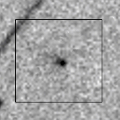
|
Now it is not observable. In the Southern Hemisphere, it will appear in the morning sky at 11 mag in late January, then it stays observable at 11 mag until June. In the Northern Hemisphere, it will appear in the morning sky in December, but it stays locating extremely low for a long time.
Date(TT) R.A. (2000) Decl. Delta r Elong. m1 Best Time(A, h)
Sept.11 12 34.19 -0 6.1 3.271 2.350 19 15.7 19:38 ( 93, -5)
Sept.18 12 46.33 -1 24.8 3.253 2.307 16 15.5 19:27 ( 93, -7)
|

|
Now it is 15.8 mag (Aug. 10, Thomas Lehmann). It will brighten up to 13 mag in 2022. In 2021, it is observable at 14-15 mag in good condition.
Date(TT) R.A. (2000) Decl. Delta r Elong. m1 Best Time(A, h)
Sept.11 14 1.23 -10 18.2 4.020 3.364 43 15.5 19:38 ( 73, 6)
Sept.18 14 9.48 -11 13.4 4.071 3.350 39 15.5 19:27 ( 73, 4)
|

|
Now it is 16.0 mag (Aug. 16, iTelescope Observatory, Siding Spring). It is expected to brighten up to 13 mag in 2022. In the Southern Hemisphere, it stays observable in good condition for a long time, although it becomes extremely low temporarily from September to October. In the Northern Hemisphere, it is not observable for a while.
Date(TT) R.A. (2000) Decl. Delta r Elong. m1 Best Time(A, h)
Sept.11 12 12.30 -26 5.9 4.900 4.100 33 15.6 19:38 ( 74,-24)
Sept.18 12 15.30 -27 4.1 4.896 4.059 30 15.5 19:27 ( 74,-27)
|
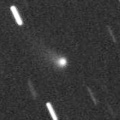
|
Now it is 15.7 mag (Aug. 11, Thomas Lehmann). In the Northern Hemisphere, it stays observable at 15-16 mag for a long time from spring to early 2022. In the Southern Hemisphere, it is not observable until the end of 2021.
Date(TT) R.A. (2000) Decl. Delta r Elong. m1 Best Time(A, h)
Sept.11 12 41.81 35 32.9 3.760 3.012 36 15.6 19:38 (122, 16)
Sept.18 12 45.71 33 26.0 3.788 3.018 34 15.6 19:27 (122, 13)
|
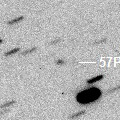
|
Now it is 16.6 mag (Aug. 28, Toshihiko Ikemura, Hirohisa Sato). It will brighten up to 15.5 mag until autumn. It stays observable for a long time.
Date(TT) R.A. (2000) Decl. Delta r Elong. m1 Best Time(A, h)
Sept.11 16 35.74 -18 51.4 1.584 1.753 81 15.6 19:38 ( 38, 26)
Sept.18 16 51.64 -19 29.0 1.629 1.742 78 15.6 19:27 ( 38, 26)
|
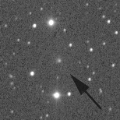
|
It brightened up to 14.2 mag in early summer (June 10, Thomas Lehmann). Now it is not observable. It will be fading after this. In the Northern Hemisphere, it will appear in the morning sky at 16 mag in October. In the Southern Hemisphere, it will never be observable again.
Date(TT) R.A. (2000) Decl. Delta r Elong. m1 Best Time(A, h)
Sept.11 11 21.94 21 27.7 3.033 2.090 16 15.6 19:38 (121, -6)
Sept.18 11 36.70 22 21.8 3.032 2.120 20 15.7 4:20 (239, -4)
|
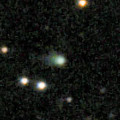
|
Now it is 15.9 mag (Aug. 29, Toshihiko Ikemura, Hirohisa Sato). It is expected to brighten up to 11 mag in 2023. In the Northern Hemisphere, it stays observable in good condition for a long time. It locates extremely low in the Southern Hemisphere.
Date(TT) R.A. (2000) Decl. Delta r Elong. m1 Best Time(A, h)
Sept.11 16 6.57 40 42.3 6.241 6.036 73 15.7 19:38 (113, 55)
Sept.18 16 5.70 39 34.4 6.254 5.993 70 15.6 19:27 (111, 52)
|
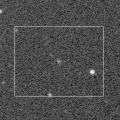
|
Now it is 16.4 mag (Aug. 20, Thomas Lehmann). It will brighten up to 12.5 mag in 2022 summer. In the Southern Hemisphere, it stays observable in excellent condition for a long time. In the Northern Hemisphere, it is not observable until August in 2022.
Date(TT) R.A. (2000) Decl. Delta r Elong. m1 Best Time(A, h)
Sept.11 3 50.41 -65 51.6 4.275 4.606 102 15.8 4:13 (358,-11)
Sept.18 3 41.06 -68 9.3 4.232 4.559 102 15.7 3:53 ( 0,-13)
|
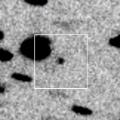
|
It will brighten up to 12 mag from winter to spring. Now it is not observable. In the Northern Hemisphere, it will appear in the morning sky at 14 mag in November. In the Southern Hemisphere, it is not observable until January.
Date(TT) R.A. (2000) Decl. Delta r Elong. m1 Best Time(A, h)
Sept.11 11 16.58 12 28.7 3.214 2.221 7 16.0 4:13 (244,-13)
Sept.18 11 30.25 10 58.9 3.166 2.181 9 15.8 4:20 (249,-10)
|
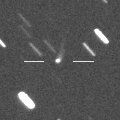
|
It was expected to brighten up to 14.5 mag from spring to summer. But actually, it is fainter than expected. Now it is 17.7 mag (July 4, Mount John Observatory, Lake Tekapo). In the Southern Hemisphere, it stays observable in excellent condition for a long time. In the Northern Hemisphere, it is not observable after this.
Date(TT) R.A. (2000) Decl. Delta r Elong. m1 Best Time(A, h)
Sept.11 10 52.08 -53 12.8 3.440 3.031 58 16.0 4:13 (314,-39)
Sept.18 11 2.69 -52 35.8 3.527 3.067 55 16.1 4:20 (314,-35)
|
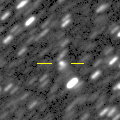
|
Now it is 15.9 mag (Aug. 24, ATLAS-HKO, Haleakala). It stays observable at 15-16 mag in good condition until autumn.
Date(TT) R.A. (2000) Decl. Delta r Elong. m1 Best Time(A, h)
Sept.11 16 34.46 -10 34.6 4.926 4.863 80 16.0 19:38 ( 44, 33)
Sept.18 16 37.10 -10 4.9 5.036 4.865 74 16.1 19:27 ( 48, 31)
|
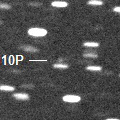
|
Now it is 16.7 mag (Aug. 29, Toshihiko Ikemura, Hirohisa Sato). It will brightens rapidly. And it will be observable at 15 mag in excellent condition in winter.
Date(TT) R.A. (2000) Decl. Delta r Elong. m1 Best Time(A, h)
Sept.11 7 10.56 26 37.1 2.764 2.467 62 16.2 4:13 (265, 43)
Sept.18 7 22.62 26 1.5 2.684 2.463 66 16.1 4:20 (268, 47)
|

|
It brightened up to 11.6 mag in winter (Feb. 18, Thomas Lehmann). Now it is fading. It has already faded down to 15.4 mag (Aug. 20, Thomas Lehmann). In the Southern Hemisphere, it stays observable in good condition after this. In the Northern Hemisphere, it will never be observable after this.
Date(TT) R.A. (2000) Decl. Delta r Elong. m1 Best Time(A, h)
Sept.11 5 10.13 -65 26.8 3.552 3.774 94 16.1 4:13 (350,-12)
Sept.18 4 57.75 -66 54.1 3.599 3.839 96 16.2 4:20 (355,-12)
|
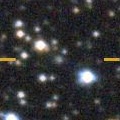
|
Now it is 15.6 mag (Sept. 3, Sandor Szabo). It is expected to brighten up to 11 mag from spring to summer in 2022. In the Southen Hemisphere, it locates somewhat low in 2021, but it will be observable in good condition at the high light for a long time. In the Northern Hemisphere, it is observable in good condition in 2021, but it will not be observable at the high light.
Date(TT) R.A. (2000) Decl. Delta r Elong. m1 Best Time(A, h)
Sept.11 18 48.41 23 17.7 3.233 3.685 108 16.2 19:38 ( 14, 78)
Sept.18 18 43.47 20 48.5 3.250 3.622 103 16.1 19:27 ( 30, 74)
|
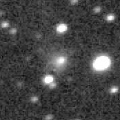
|
Now it is 16.4 mag (Aug. 30, Toshihiko Ikemura, Hirohisa Sato). It is observable at 16 mag from 2020 to 2021. It locates low in the Southern Hemisphere.
Date(TT) R.A. (2000) Decl. Delta r Elong. m1 Best Time(A, h)
Sept.11 22 2.94 39 31.7 5.371 6.098 132 16.3 22:40 (180, 85)
Sept.18 21 56.53 38 8.9 5.379 6.109 133 16.3 22:06 (180, 87)
|
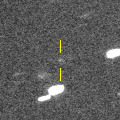
|
Now it is 17.3 mag (Aug. 29, Toshihiko Ikemura, Hirohisa Sato). It stays observable at 16 mag from autumn to winter. In the Northern Hemisphere, it stays observable in good condition. In the Southern Hemisphere, it stays extremely low until November.
Date(TT) R.A. (2000) Decl. Delta r Elong. m1 Best Time(A, h)
Sept.11 8 42.54 24 28.2 2.409 1.792 41 16.5 4:13 (256, 24)
Sept.18 9 1.56 23 1.1 2.363 1.785 44 16.4 4:20 (259, 26)
|
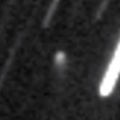
|
Now it is 17.5 mag (Aug. 20, ATLAS-MLO, Mauna Loa). It will brighten up to 15.5 mag in winter. In the Northern Hemisphere, it stays observable in good condition for a long time. It is not observable at all in the Southern Hemisphere.
Date(TT) R.A. (2000) Decl. Delta r Elong. m1 Best Time(A, h)
Sept.11 15 54.82 69 0.7 3.334 3.284 78 16.5 19:38 (157, 47)
Sept.18 15 46.91 67 41.5 3.318 3.254 77 16.4 19:27 (154, 46)
|
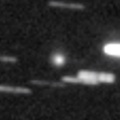
|
Now it is 16.4 mag (Aug. 30, Toshihiko Ikemura, Hirohisa Sato). It is expected to brighten up to 11 mag in 2023. In the Northern Hemisphere, it is observable in good condition in 2021. But it is observable only until November in 2022. In the Southern Hemisphere, it locates extremely low in 2021. But it will be observable in good condition at the high light.
Date(TT) R.A. (2000) Decl. Delta r Elong. m1 Best Time(A, h)
Sept.11 17 25.64 34 52.3 6.180 6.247 89 16.5 19:38 ( 96, 71)
Sept.18 17 25.64 33 30.1 6.195 6.199 85 16.5 19:27 ( 94, 67)
|
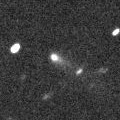
|
Now it is 16.3 mag (Sept. 1, ATLAS-HKO, Haleakala). It stays observable at 16.5 mag in good condition until October.
Date(TT) R.A. (2000) Decl. Delta r Elong. m1 Best Time(A, h)
Sept.11 23 15.42 0 29.0 1.167 2.171 174 16.5 23:52 ( 0, 56)
Sept.18 23 9.70 0 45.6 1.176 2.175 171 16.5 23:19 ( 0, 56)
|
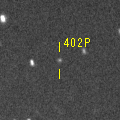
|
First return of a new periodic comet observed at 16 mag from 2003 to 2004. Now it is 17.4 mag (Aug. 27, J. L. Virlichie, P. Traverse). It will brighten up to 16 mag in winter, and it will be observable in excellent condition.
Date(TT) R.A. (2000) Decl. Delta r Elong. m1 Best Time(A, h)
Sept.11 6 19.17 2 0.7 4.128 3.975 74 16.6 4:13 (301, 39)
Sept.18 6 24.23 1 50.1 4.031 3.970 79 16.5 4:20 (308, 44)
|
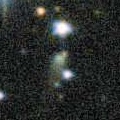
|
Now it is 15.8 mag (Sept. 3, Sandor Szabo). It stays at 16-17 mag from 2020 to 2021. In the Northern Hemisphere, it stays observable in good condition for a long time. It locates extremely low in the Southern Hemisphere.
Date(TT) R.A. (2000) Decl. Delta r Elong. m1 Best Time(A, h)
Sept.11 18 23.87 50 19.1 8.707 8.886 96 16.6 19:38 (159, 73)
Sept.18 18 21.85 49 55.3 8.748 8.891 94 16.6 19:27 (150, 72)
|
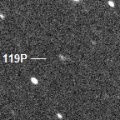
|
Now it is 17.9 mag (Aug. 28, ATLAS-HKO, Haleakala). It will brighten up to 14.5 mag in 2022 winter. In 2021, it stays observable in good condition while the comet will be brightening gradually. It is fainter than this ephemeris recently.
Date(TT) R.A. (2000) Decl. Delta r Elong. m1 Best Time(A, h)
Sept.11 22 40.94 -17 47.7 2.190 3.171 164 16.7 23:18 ( 0, 37)
Sept.18 22 36.11 -18 18.4 2.195 3.145 157 16.7 22:46 ( 0, 37)
|
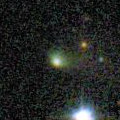
|
Now it is 15.7 mag (Aug. 29, Toshihiko Ikemura, Hirohisa Sato). It will be fading after this, and it will be fainter than 18 mag in November.
Date(TT) R.A. (2000) Decl. Delta r Elong. m1 Best Time(A, h)
Sept.11 1 15.19 -10 28.3 1.874 2.792 150 16.7 1:56 ( 0, 45)
Sept.18 1 13.26 -11 28.5 1.877 2.822 155 16.8 1:27 ( 0, 44)
|
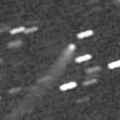
|
Now it is 16.9 mag (Aug. 29, Toshihiko Ikemura, Hirohisa Sato). Fading slowly. In the Northern Hemisphere, it stays observable in good condition for a long time. It is not observable after this in the Southern Hemisphere.
Date(TT) R.A. (2000) Decl. Delta r Elong. m1 Best Time(A, h)
Sept.11 16 14.49 51 46.4 5.878 5.732 76 16.9 19:38 (132, 56)
Sept.18 16 13.64 51 0.6 5.947 5.765 74 17.0 19:27 (130, 54)
|

|
Now it is 17.4 mag (Aug. 29, Toshihiko Ikemura, Hirohisa Sato). In the Northern Hemisphere, it stays observable for a long time while it is getting fainter slowly. In the Southern Hemisphere, it will never be observable again.
Date(TT) R.A. (2000) Decl. Delta r Elong. m1 Best Time(A, h)
Sept.11 13 49.90 46 54.2 7.242 6.693 53 17.0 19:38 (127, 33)
Sept.18 13 53.87 45 57.6 7.304 6.741 52 17.0 19:27 (127, 30)
|
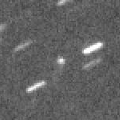
|
Now it is 17.7 mag (Sept. 1, D. Buczynski). It will brighten up to 16 mag in 2022. In the Northern Hemisphere, it stays observable in good condition for a long time. In the Southern Hemisphere, it is not observable until 2023.
Date(TT) R.A. (2000) Decl. Delta r Elong. m1 Best Time(A, h)
Sept.11 8 25.03 51 32.7 4.692 4.259 58 17.1 4:13 (228, 37)
Sept.18 8 33.43 52 49.2 4.575 4.231 63 17.1 4:20 (227, 41)
|

|
Peculiar asteroid moving along a cometary orbit. It brightens up to 17 mag from September to October. In the Northern Hemisphere, it is observable in excellent condition. It is not observable in the Southern Hemisphere.
Date(TT) R.A. (2000) Decl. Delta r Elong. m1 Best Time(A, h)
Sept.11 8 39.64 43 9.6 0.448 0.810 51 17.5 4:13 (237, 32)
Sept.18 8 36.64 60 13.9 0.470 0.937 68 17.1 4:20 (218, 41)
|
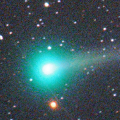
|
It brightened up to 3 mag in December in the SOHO spacecraft images (Dec. 18, Hirohisa Sato). Now it is 17.0 mag (Aug. 29, ATLAS-HKO, Haleakala). It stays observable in good condition after this while the comet will be fading.
Date(TT) R.A. (2000) Decl. Delta r Elong. m1 Best Time(A, h)
Sept.11 23 39.80 17 41.4 3.304 4.248 156 17.1 0:21 ( 0, 73)
Sept.18 23 33.62 16 54.0 3.364 4.326 161 17.2 23:43 ( 0, 72)
|
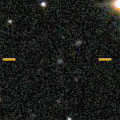
|
Now it is 18.4 mag (Aug. 30, Toshihiko Ikemura, Hirohisa Sato). It will brightens rapidly. And it is expected to be observable at 12-13 mag in good condition from December to February.
Date(TT) R.A. (2000) Decl. Delta r Elong. m1 Best Time(A, h)
Sept.11 22 11.51 -1 48.1 0.861 1.848 163 17.5 22:48 ( 0, 53)
Sept.18 22 2.77 -3 0.7 0.825 1.788 155 17.1 22:12 ( 0, 52)
|
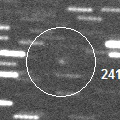
|
Now it is 17.3 mag (Aug. 28, Toshihiko Ikemura, Hirohisa Sato). In the Northern Hemisphere, it stays observable at 17 mag in good condition until winter. In the Southern Hemisphere, it stays locating extremely low for a while.
Date(TT) R.A. (2000) Decl. Delta r Elong. m1 Best Time(A, h)
Sept.11 7 26.76 35 22.3 2.251 1.971 61 17.2 4:13 (252, 43)
Sept.18 7 43.25 34 27.2 2.209 1.987 64 17.2 4:20 (254, 46)
|
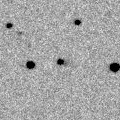
|
Now it is 17.5 mag (Aug. 12, Michael Jager). It is observable at 17 mag in good condition in autumn.
Date(TT) R.A. (2000) Decl. Delta r Elong. m1 Best Time(A, h)
Sept.11 2 31.76 18 36.8 3.140 3.827 126 17.3 3:12 ( 0, 74)
Sept.18 2 31.53 18 21.8 3.062 3.824 133 17.3 2:45 ( 0, 73)
|
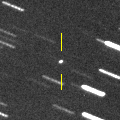
|
Now it is 17.1 mag (Aug. 18, Toshiyuki Takahashi). In the Northern Hemisphere, it stays observable in good condition after this while the comet will be fading. In the Southern Hemisphere, it stays locating extremely low for a long time.
Date(TT) R.A. (2000) Decl. Delta r Elong. m1 Best Time(A, h)
Sept.11 5 14.36 37 32.0 2.426 2.588 87 17.3 4:13 (255, 69)
Sept.18 5 19.77 38 18.1 2.391 2.643 93 17.3 4:20 (252, 75)
|

|
Now it is 17.7 mag (May 12, ATLAS-HKO, Haleakala). It brightened rapidly. It stays 17-18 mag for a long time from 2021 to 2022. In the Southern Hemisphere, it stays observable in good condition for a long time. In the Northern Hemisphere, it will be observable only in extremely low sky from autumn to winter.
Date(TT) R.A. (2000) Decl. Delta r Elong. m1 Best Time(A, h)
Sept.11 8 59.47 -19 42.8 6.064 5.353 41 17.4 4:13 (291, -5)
Sept.18 9 1.99 -20 59.6 6.008 5.349 45 17.4 4:20 (296, 0)
|
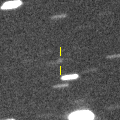
|
Now it is 17.4 mag (Aug. 28, Toshihiko Ikemura, Hirohisa Sato). It will brighten up to 15.5 mag, and will be observable in excellent condition in winter.
Date(TT) R.A. (2000) Decl. Delta r Elong. m1 Best Time(A, h)
Sept.11 8 9.61 18 16.7 2.594 2.055 47 17.6 4:13 (266, 27)
Sept.18 8 25.73 17 36.6 2.530 2.044 50 17.5 4:20 (269, 30)
|

|
It stays 17 mag for a long time from 2021 to 2022. It is observable in excellent condition in the Northern Hemisphere, It locates somewhat low in the Southern Hemisphere.
Date(TT) R.A. (2000) Decl. Delta r Elong. m1 Best Time(A, h)
Sept.11 5 34.67 32 40.4 5.594 5.573 83 17.7 4:13 (266, 65)
Sept.18 5 31.52 32 59.0 5.449 5.559 91 17.6 4:20 (270, 72)
|
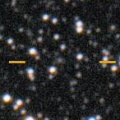
|
Now it is 17.4 mag (Aug. 30, Toshihiko Ikemura, Hirohisa Sato). It stays observable at 17-18 mag for a long time from 2021 to 2022.
Date(TT) R.A. (2000) Decl. Delta r Elong. m1 Best Time(A, h)
Sept.11 19 4.93 -18 55.6 3.548 4.106 117 17.6 19:43 ( 0, 36)
Sept.18 19 6.30 -18 58.1 3.638 4.101 110 17.6 19:27 ( 3, 36)
|
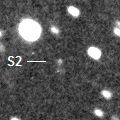
|
First return of a new periodic comet which brightened up to 17 mag in 2012. Now it is 18.0 mag (Aug. 13, ATLAS-MLO, Mauna Loa). In the Southern Hemisphere, it is observable at 17.5 mag in excellent condition in summer. It locates low in the Northern Hemisphere.
Date(TT) R.A. (2000) Decl. Delta r Elong. m1 Best Time(A, h)
Sept.11 19 40.39 -40 11.1 0.710 1.494 119 17.6 20:19 ( 0, 15)
Sept.18 19 49.24 -39 10.5 0.714 1.462 115 17.6 20:01 ( 0, 16)
|
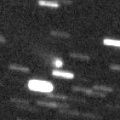
|
Now it is 16.1 mag (Aug. 17, ATLAS-MLO, Mauna Loa). It will be fading after this, and it will be fainter than 18 mag in October.
Date(TT) R.A. (2000) Decl. Delta r Elong. m1 Best Time(A, h)
Sept.11 15 8.79 -23 31.6 5.619 5.242 63 17.6 19:38 ( 52, 10)
Sept.18 15 9.21 -24 0.5 5.753 5.268 56 17.7 19:27 ( 54, 7)
|

|
Now it is 17.0 mag (Aug. 26, J. Drummond). It will brighten up to 16.5-17 mag in winter. In its last apparition in 2015, it brightened up to 13 mag.
Date(TT) R.A. (2000) Decl. Delta r Elong. m1 Best Time(A, h)
Sept.11 21 59.03 -31 51.2 1.449 2.360 147 17.7 22:36 ( 0, 23)
Sept.18 21 53.39 -32 31.2 1.454 2.318 140 17.7 22:03 ( 0, 23)
|

|
It had been observed as 8-9 mag for a long time in 2020. Now it is fading. It has already faded down to 18.3 mag (Aug. 19, J. Drummond). It will be observable in good condition after this in the Southern Hemisphere. It locates extremely low after this in the Northern Hemisphere.
Date(TT) R.A. (2000) Decl. Delta r Elong. m1 Best Time(A, h)
Sept.11 16 13.48 -45 9.8 5.739 5.693 82 17.7 19:38 ( 28, 1)
Sept.18 16 16.68 -45 8.1 5.902 5.754 76 17.8 19:27 ( 30, 0)
|
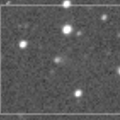
|
First return of a new periodic comet which brightened up to 17 mag in 2006. Now it is 16.3 mag (Aug. 19, J. Drummond). It stays 18 mag from 2021 to 2022.
Date(TT) R.A. (2000) Decl. Delta r Elong. m1 Best Time(A, h)
Sept.11 21 40.92 -67 35.7 2.666 3.223 114 17.7 22:19 ( 0,-12)
Sept.18 21 35.07 -66 24.7 2.698 3.211 111 17.7 21:45 ( 0,-11)
|
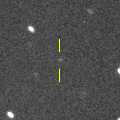
|
Now it is 18.2 mag (Aug. 28, Toshihiko Ikemura, Hirohisa Sato). It has passed the perihelion in 2020 October. At the discovery in 2005, it stayed bright for several years even after the perihelion passage. In this apparition, it may stay observable at 18 mag from 2021 to 2024.
Date(TT) R.A. (2000) Decl. Delta r Elong. m1 Best Time(A, h)
Sept.11 23 34.31 -28 52.5 3.002 3.940 155 17.7 0:16 ( 0, 26)
Sept.18 23 30.37 -29 14.2 3.042 3.961 152 17.7 23:40 ( 0, 26)
|
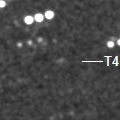
|
Now it is extremely faint as 20.5 mag (June 17, M. Jaeger, E. Prosperi, S. Prosperi). It was predicted to brighten up to 17.5 mag in 2021 summer. But actually, it is much fainter than predicted. It is not observable in the Southern Hemisphere.
Date(TT) R.A. (2000) Decl. Delta r Elong. m1 Best Time(A, h)
Sept.11 14 11.79 45 22.8 2.741 2.327 55 17.9 19:38 (124, 36)
Sept.18 14 23.65 41 33.5 2.806 2.356 53 18.0 19:27 (120, 34)
|
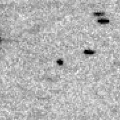
|
Now it is 18.2 mag (Sept. 7, Katsumi Yoshimoto). It is expected to brighten up to 4.5 mag in 2022 April. However, it is not observable at the high light. In the Northern Hemisphere, it stays observable until early February when it brightens up to 14 mag. Then it will appear at 6 mag in mid May, and it stays observable in good condition after that while the comet will be fading. In the Southern Hemisphere, it stays observable until December when it brightens up to 16 mag. But after that, it is not observable until 2022 August.
Date(TT) R.A. (2000) Decl. Delta r Elong. m1 Best Time(A, h)
Sept.11 22 48.09 26 6.9 2.873 3.768 148 18.1 23:25 ( 0, 81)
Sept.18 22 39.93 25 3.9 2.785 3.683 149 17.9 22:49 ( 0, 80)
|

|
Now it is 19.0 mag (Aug. 25, B. T. Bolin, Z. T. F. Collaboration). It will brighten rapidly, and it will be observable at 13.5 mag in good condition from winter to spring.
Date(TT) R.A. (2000) Decl. Delta r Elong. m1 Best Time(A, h)
Sept.11 8 15.85 22 51.1 3.557 2.966 47 18.1 4:13 (261, 28)
Sept.18 8 26.35 22 20.6 3.458 2.941 51 17.9 4:20 (264, 33)
|

|
Now it is 17.6 mag (Aug. 30, Toshihiko Ikemura, Hirohisa Sato). It will be fading slowly.
Date(TT) R.A. (2000) Decl. Delta r Elong. m1 Best Time(A, h)
Sept.11 16 52.75 -10 44.1 8.066 8.041 85 17.9 19:38 ( 39, 35)
Sept.18 16 52.17 -10 40.4 8.213 8.068 78 18.0 19:27 ( 44, 33)
|
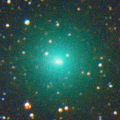
|
It brightened up to 8.2 mag in 2020 autumn (Oct. 13, 2020, Chris Wyatt). Now it is 18.3 mag (Aug. 19, ATLAS-MLO, Mauna Loa). It is observable at 18 mag in 2021.
Date(TT) R.A. (2000) Decl. Delta r Elong. m1 Best Time(A, h)
Sept.11 5 12.16 23 20.1 3.118 3.262 89 17.9 4:13 (292, 65)
Sept.18 5 14.80 23 28.4 3.049 3.298 95 18.0 4:20 (303, 71)
|
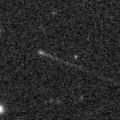
|
Now it is 18.2 mag (Sept. 8, Michael Jager). Main-belt asteroid, but it has a long tail of 10 arcmin (Sept. 4, Michael Jager). It stays observable in good condition until winter.
Date(TT) R.A. (2000) Decl. Delta r Elong. m1 Best Time(A, h)
Sept.11 0 1.00 0 6.4 1.462 2.455 167 19.2 0:42 ( 0, 55)
Sept.18 23 55.84 -0 27.4 1.461 2.465 176 19.0 0:10 ( 0, 55)
|
|
![]()
 C/2020 S3 ( Erasmus )
C/2020 S3 ( Erasmus ) 104P/Kowal 2
104P/Kowal 2 241P/LINEAR
241P/LINEAR P/2021 N2 ( Fuls )
P/2021 N2 ( Fuls ) 28P/Neujmin 1
28P/Neujmin 1 C/2020 F7 ( Lemmon )
C/2020 F7 ( Lemmon ) 70P/Kojima
70P/Kojima C/2020 U4 ( PanSTARRS )
C/2020 U4 ( PanSTARRS ) 395P/2020 H1 ( Catalina-NEAT )
395P/2020 H1 ( Catalina-NEAT ) 424P/2021 L5 ( La Sagra )
424P/2021 L5 ( La Sagra ) C/2017 Y2 ( PanSTARRS )
C/2017 Y2 ( PanSTARRS ) 230P/LINEAR
230P/LINEAR C/2017 T2 ( PanSTARRS )
C/2017 T2 ( PanSTARRS ) 422P/2021 L1 ( Christensen )
422P/2021 L1 ( Christensen ) 378P/2019 E2 ( McNaught )
378P/2019 E2 ( McNaught ) C/2020 T4 ( PanSTARRS )
C/2020 T4 ( PanSTARRS ) C/2021 O3 ( PanSTARRS )
C/2021 O3 ( PanSTARRS ) 116P/Wild 4
116P/Wild 4 C/2017 U7 ( PanSTARRS )
C/2017 U7 ( PanSTARRS ) 88P/Howell
88P/Howell (248370) 2005 QN173
(248370) 2005 QN173![]()








































































